船舶结构图
- 格式:pdf
- 大小:1.45 MB
- 文档页数:12
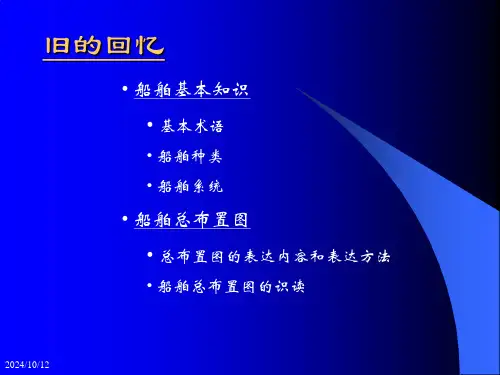
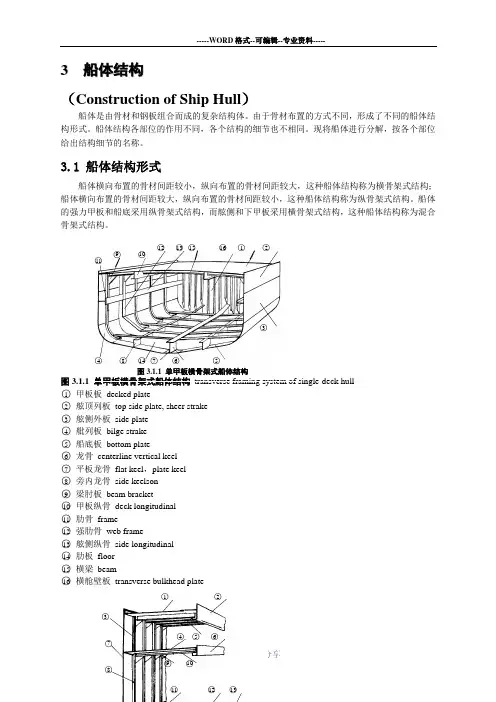
--完整版学习资料分享---- 3 船体结构(Construction of Ship Hull )船体是由骨材和钢板组合而成的复杂结构体。
由于骨材布置的方式不同,形成了不同的船体结构形式。
船体结构各部位的作用不同,各个结构的细节也不相同。
现将船体进行分解,按各个部位给出结构细节的名称。
3.1 船体结构形式船体横向布置的骨材间距较小,纵向布置的骨材间距较大,这种船体结构称为横骨架式结构;船体横向布置的骨材间距较大,纵向布置的骨材间距较小,这种船体结构称为纵骨架式结构。
船体的强力甲板和船底采用纵骨架式结构,而舷侧和下甲板采用横骨架式结构,这种船体结构称为混合骨架式结构。
图3.1.1 单甲板横骨架式船体结构 transverse framing system of single-deck hull○1 甲板板 decked plate ○2 舷顶列板 top side plate, sheer strake ○3 舷侧外板 side plate ○4 舭列板 bilge strake ○5 船底板 bottom plate ○6 龙骨 centerline vertical keel ○7 平板龙骨 flat keel ,plate keel ○8 旁内龙骨 side keelson ○9 梁肘板 beam bracket ○10 甲板纵骨 deck longitudinal ○11 肋骨 frame ○12 强肋骨 web frame ○13 舷侧纵骨 side longitudinal ○14 肋板 floor ○15 横梁 beam ○16 横舱壁板 transverse bulkhead plate○1 ○2○3○4 ○5 ○6○7○9 ○10 ○8○11 ○12 ○13○12 ○13 ○15 ○16 ○1 ○2○9 ○10○11○3 ○4 ○8 ○14 ○7 ○6 ○5 图3.1.1 单甲板横骨架式船体结构--完整版学习资料分享----图3.1.2 有二层甲板横骨架式船体结构 transverse framing system of two-decked hull ○1 上甲板 upper deck ○2 上甲板舱口围板 hatch coaming on upper deck ○3 甲板间肋骨 tweendeck frame ○4 二甲板 second deck ○5 甲板横梁 deck beam ○6 二甲板舱口围板 hatch coaming on second deck ○7 船侧外板 side plate ○8 舱内肋骨 hold frame ○9 肘板 bracket ○10 横梁 beam ○11 舭肘板 bilge bracket ○12 主肋板 main floor ○13 内底板 inner bottom plate ○14 舭部外板 bilge strake ○15 舭龙骨 bilge keel○16 扶强材 stiffener ○17 旁底桁 bottom side girder ○18 船底板 bottom plate ○19 中底桁 bottom central girder图3.1.3 纵骨架式船体结构 longitudinal framing system of hull○1 上甲板 upper deck ○2 甲板纵桁 deck girder ○3 甲板纵骨 deck longitudinal ○4 舷侧外板 top side plating ○5 强横梁 web beam ○1 ○2 ○3○4○5○6 ○7 ○8 ○9 ○10 ○11 ○12○13 ○14 ○15○16 ○17 ○18 ○19图3.1.3纵骨架式船体结构--完整版学习资料分享---- ○6 水平扶强材 horizontal stiffener ○7 强横梁 web beam ○8 肘板 bracket ○9 舷侧纵骨 deck longitudinal ○10 纵舱壁 longitudinal bulkhead ○11 强肋骨 web frame ○12 撑材 strut ○13 肋板 floor ○14 面板 face plate ○15 肋板 bottom transverse ○16 舭龙骨 bilge keel ○17 船底纵骨 bottom longitudinal ○18 船底纵桁 bottom girder ○19 船底板 bottom plate图3.1.4 混合骨架式船体结构 combined framing system of hull○1 船底板 bottom plate ○2 中纵桁 center girder ○3 旁纵桁 side girder ○4 内底边板 margin plate ○5 船底纵骨 bottom longitudinal ○6 内底板 inner bottom plating ○7 内底纵骨 inner bottom longitudinal ○8 肘板 bracket ○9 主肋板 main floor ○10 舭龙骨 bilge keel ○11 舱内肋骨 hold frame ○12 甲板纵桁 deck girder ○13 舷侧外板 side plating ○14 上甲板 upper deck ○15 甲板纵桁 deck girder ○16 甲板纵骨 deck longitudinal ○17 甲板横梁 deck beam ○18 二层甲板 second deck ○19 三层甲板 third deck○14 ○15 ○16 ○17○18 ○13○19○11○12○7 ○6 ○4○10 ○8○9 ○5 ○3 ○2 ○1图3.1.4 混合骨架式船体结构--完整版学习资料分享----3.2 船首结构船的首部是指上甲板以下,防撞舱壁以前的船体,这部分船体处于船的最前端。


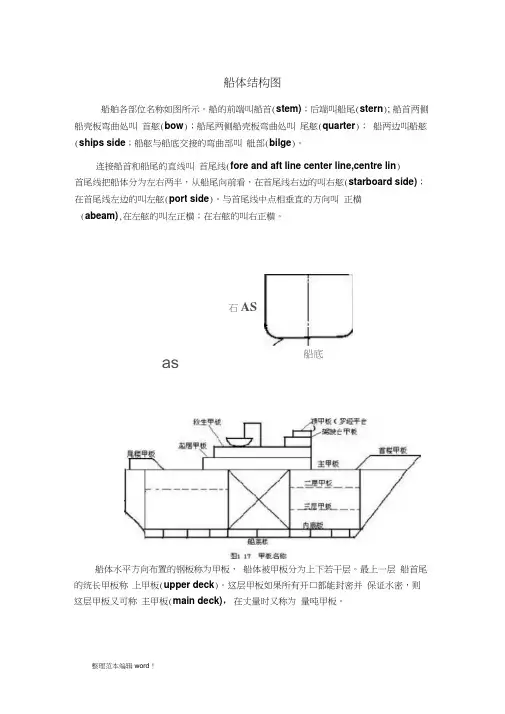
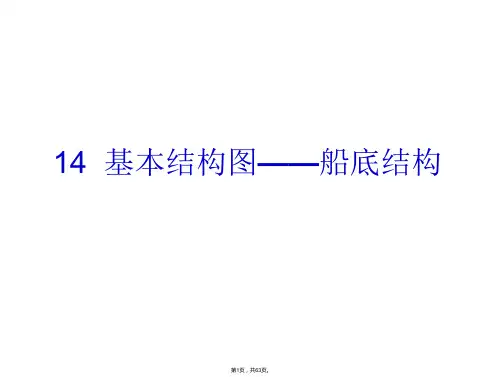
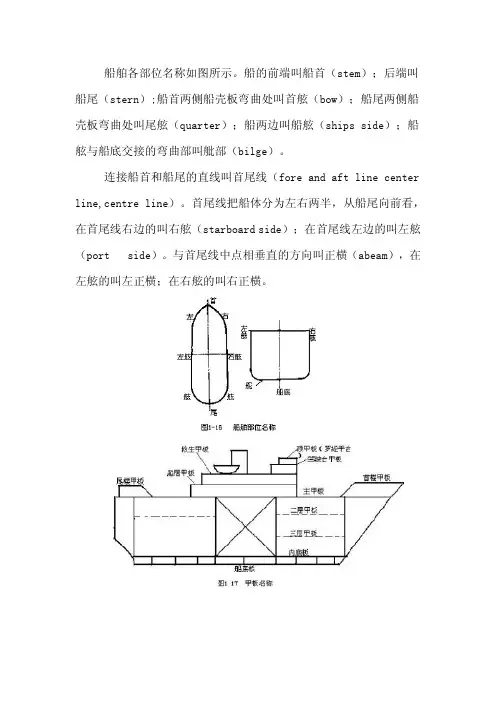
船舶各部位名称如图所示。
船的前端叫船首(stem);后端叫船尾(stern);船首两侧船壳板弯曲处叫首舷(bow);船尾两侧船壳板弯曲处叫尾舷(quarter);船两边叫船舷(ships side);船舷与船底交接的弯曲部叫舭部(bilge)。
连接船首和船尾的直线叫首尾线(fore and aft line center line,centre line)。
首尾线把船体分为左右两半,从船尾向前看,在首尾线右边的叫右舷(starboard side);在首尾线左边的叫左舷(port side)。
与首尾线中点相垂直的方向叫正横(abeam),在左舷的叫左正横;在右舷的叫右正横。
船体水平方向布置的钢板称为甲板,船体被甲板分为上下若干层。
最上一层船首尾的统长甲板称上甲板(upper deck)。
这层甲板如果所有开口都能封密并保证水密,则这层甲板又可称主甲板(main deck),在丈量时又称为量吨甲板。
少数远洋船舶在主甲板上还有一层贯通船首尾的上甲板,由于其开口不能保证水密,所以只能叫遮蔽甲板(shelter deck)。
主甲板把船分为上下两部分,在主甲板以上的部分统称为上层建筑;主甲板以下部分叫主船体。
在主甲板以下的各层统长甲板,从上到下依次叫二层甲板、三层甲板等等。
在主甲板以上均为短段甲板,习惯上是按照该层甲板的舱室名称或用途来命名的。
如驾驶台甲板(bridge deck)、救生艇甲板(life-boat deck)、等等 。
在主船体内,根据需要用横向舱壁分隔成很多大小不同的舱室,这些舱室都按照各自的用途或所在部位而命名,如图1-18所示,从首到尾分别叫首尖舱、锚链舱、货舱、机舱、尾尖舱和压载舱等。
在货舱中两层甲板之间所形成的舱间称甲板间舱(tween deck),也叫二层舱或二层柜。
上层建筑分船楼和甲板室两大类型。
所谓船楼是指两侧都延伸至船舷或很接近船舷的上层建筑;甲板室是指两侧不接近舷边的上层建筑。
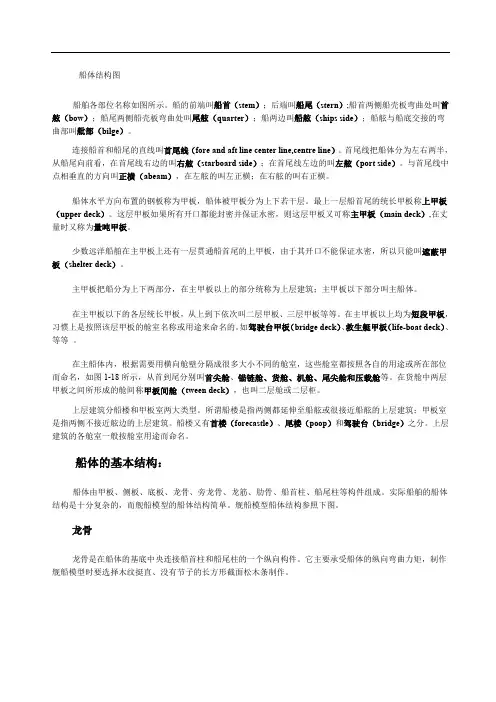
船体结构图船舶各部位名称如图所示。
船的前端叫船首(stem);后端叫船尾(stern);船首两侧船壳板弯曲处叫首舷(bow);船尾两侧船壳板弯曲处叫尾舷(quarter);船两边叫船舷(ships side);船舷与船底交接的弯曲部叫舭部(bilge)。
连接船首和船尾的直线叫首尾线(fore and aft line center line,centre line)。
首尾线把船体分为左右两半,从船尾向前看,在首尾线右边的叫右舷(starboard side);在首尾线左边的叫左舷(port side)。
与首尾线中点相垂直的方向叫正横(abeam),在左舷的叫左正横;在右舷的叫右正横。
船体水平方向布置的钢板称为甲板,船体被甲板分为上下若干层。
最上一层船首尾的统长甲板称上甲板(upper deck)。
这层甲板如果所有开口都能封密并保证水密,则这层甲板又可称主甲板(main deck),在丈量时又称为量吨甲板。
少数远洋船舶在主甲板上还有一层贯通船首尾的上甲板,由于其开口不能保证水密,所以只能叫遮蔽甲板(shelter deck)。
主甲板把船分为上下两部分,在主甲板以上的部分统称为上层建筑;主甲板以下部分叫主船体。
在主甲板以下的各层统长甲板,从上到下依次叫二层甲板、三层甲板等等。
在主甲板以上均为短段甲板,习惯上是按照该层甲板的舱室名称或用途来命名的。
如驾驶台甲板(bridge deck)、救生艇甲板(life-boat deck)、等等。
在主船体内,根据需要用横向舱壁分隔成很多大小不同的舱室,这些舱室都按照各自的用途或所在部位而命名,如图1-18所示,从首到尾分别叫首尖舱、锚链舱、货舱、机舱、尾尖舱和压载舱等。
在货舱中两层甲板之间所形成的舱间称甲板间舱(tween deck),也叫二层舱或二层柜。
上层建筑分船楼和甲板室两大类型。
所谓船楼是指两侧都延伸至船舷或很接近船舷的上层建筑;甲板室是指两侧不接近舷边的上层建筑。
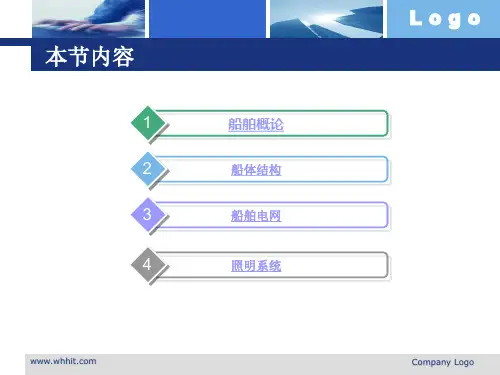

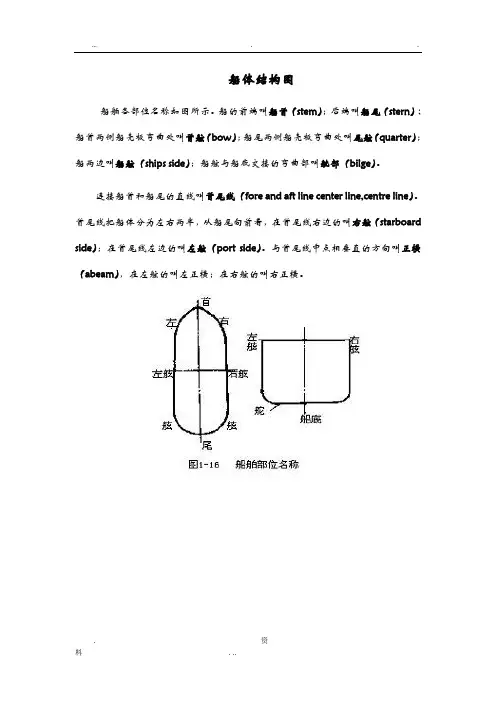
船体结构图船舶各部位名称如图所示。
船的前端叫船首(stem);后端叫船尾(stern);船首两侧船壳板弯曲处叫首舷(bow);船尾两侧船壳板弯曲处叫尾舷(quarter);船两边叫船舷(ships side);船舷与船底交接的弯曲部叫舭部(bilge)。
连接船首和船尾的直线叫首尾线(fore and aft line center line,centre line)。
首尾线把船体分为左右两半,从船尾向前看,在首尾线右边的叫右舷(starboard side);在首尾线左边的叫左舷(port side)。
与首尾线中点相垂直的方向叫正横(abeam),在左舷的叫左正横;在右舷的叫右正横。
船体水平方向布置的钢板称为甲板,船体被甲板分为上下若干层。
最上一层船首尾的统长甲板称上甲板(upper deck)。
这层甲板如果所有开口都能封密并保证水密,则这层甲板又可称主甲板(main deck),在丈量时又称为量吨甲板。
少数远洋船舶在主甲板上还有一层贯通船首尾的上甲板,由于其开口不能保证水密,所以只能叫遮蔽甲板(shelter deck)。
主甲板把船分为上下两部分,在主甲板以上的部分统称为上层建筑;主甲板以下部分叫主船体。
在主甲板以下的各层统长甲板,从上到下依次叫二层甲板、三层甲板等等。
在主甲板以上均为短段甲板,习惯上是按照该层甲板的舱室名称或用途来命名的。
如驾驶台甲板(bridge deck)、救生艇甲板(life-boat deck)、等等。
在主船体,根据需要用横向舱壁分隔成很多大小不同的舱室,这些舱室都按照各自的用途或所在部位而命名,如图1-18所示,从首到尾分别叫首尖舱、锚链舱、货舱、机舱、尾尖舱和压载舱等。
在货舱中两层甲板之间所形成的舱间称甲板间舱(tween deck),也叫二层舱或二层柜。
上层建筑分船楼和甲板室两大类型。
所谓船楼是指两侧都延伸至船舷或很接近船舷的上层建筑;甲板室是指两侧不接近舷边的上层建筑。
图2-58 船体中纵剖面图
1-首柱;2-球鼻首;3-首柱纵向加强筋;4-首柱水平肘板;5-甲板横梁;6-加强横梁;7-纵中甲板纵桁;8-支柱;9-舱壁板;10-纵向制荡舱壁;11-强胸横梁;12-首尖舱高肋板;13-中内龙骨;14-防撞舱壁;15-舱口围板;16-舱口纵桁;17-纵中舱壁;18-舷侧纵桁;19-中桁材;20-内底骨材;22-横向制荡舱壁;23-水密横舱壁;24-水(油)密肋板;25-甲板室前端壁板;26-机舱棚前壁板;27-深舱横舱壁;28-尾尖舱水密横舱壁;29-深舱纵中制荡舱壁;30-舷侧纵桁;31-尾尖舱高肋板;32-肋骨;33-肋板;34-尾柱上端;35-推进器柱;36-尾柱下部(舵托)
图2-59 内底结构图
图2-60 外板展开图。
船体主要构件结构图船体结构图船舶各部位名称如图所示。
船的前端叫船首(stem);后端叫船尾(stern);船首两侧船壳板弯曲处叫首舷(bow);船尾两侧船壳板弯曲处叫尾舷(quarter);船两边叫船舷(ships side);船舷与船底交接的弯曲部叫舭部(bilge)。
连接船首和船尾的直线叫首尾线(fore and aft line center line,centre line)。
首尾线把船体分为左右两半,从船尾向前看,在首尾线右边的叫右舷(starboard side);在首尾线左边的叫左舷(port side)。
与首尾线中点相垂直的方向叫正横(abeam),在左舷的叫左正横;在右舷的叫右正横。
船体水平方向布置的钢板称为甲板,船体被甲板分为上下若干层。
最上一层船首尾的统长甲板称上甲板(upper deck)。
这层甲板如果所有开口都能封密并保证水密,则这层甲板又可称主甲板(main deck),在丈量时又称为量吨甲板。
上层建筑分船楼和甲板室两大类型。
所谓船楼是指两侧都延伸至船舷或很接近船舷的上层建筑;甲板室是指两侧不接近舷边的上层建筑。
船楼又有首楼(forecastle)、尾楼(poop)和驾驶台(bridge)之分。
上层建筑的各舱室一般按舱室用途而命名。
船体的基本结构:船体由甲板、侧板、底板、龙骨、旁龙骨、龙筋、肋骨、船首柱、船尾柱等构件组成。
实际船舶的船体结构是十分复杂的,而舰船模型的船体结构简单。
舰船模型船体结构参照下图。
龙骨龙骨是在船体的基底中央连接船首柱和船尾柱的一个纵向构件。
它主要承受船体的纵向弯曲力矩,制作舰船模型时要选择木纹挺直、没有节子的长方形截面松木条制作。
旁龙骨旁龙骨是在龙骨两侧的纵向构件。
它承受部分纵向弯曲力矩,并且提高船体承受外力的强度。
舰船的旁龙骨常用长方形截面松木条制作。
肋骨肋骨是船体内的横向构件。
它承受横向水压力,保持船体的几何形状。
舰船模型的肋骨常用三合板制作。
Unit 1SHIPS AND SHIPS TERMSSHIP DESIGN AND CONSTRUCTION(general introduction)Basictermshullsuperstructure machinerysternbowamidshipsbeamdeck engine room propeller shaft bow thruster rudder bulbous bow hold1 A multi-purpose vessel2 An oil tanker3 A container vessel4 A roll-on/roll-of ship5 bulk carrier - elevation / profile6 A bulkcarrier – upper/main deck planShips are large, complex vehicles which must be self-sustaining in their environment for long periods with a high degree of reliability. A ship is the product of three main areas of skill, those of the naval architect , the navigating officer (deck officer) and the marine engineer (engineering officer). The naval architect is concerned with the hull, its construction, form, habitability and ability to endure its environment. The navigating officer is responsible for safe navigation of the ship, and its cargo operations. The marine engineer is responsible for the various systems which propel and operate the ship. More specifically, this means the machinery required for propulsion, steering, anchoring and ship securing, cargo handling, air conditioning, power generation and its distribution.There are two main parts of a ship: the hull and the machinery. The hull is the actual shell of the ship including her superstructure,The machinery includes not only the main engines required to drive her but also the auxiliary machinery (boilers, generators, etc.) used for manoeuvring purposes, steering, mooring, cargo handling and for various other services, e.g. the electrical installations, winches and refrigerating plant.The rear portion of the ship is called the after end or stern. When moving stern first, the vessel is said to be moving astern. The front portion of the ship is called the fore end, whilst the extreme forward end is called the bow. When moving bow first, the vessel is said to be moving ahead. Fore and aft are generally used for directional purposes. The area between the forward and aft portions of the vessel is called amidships.The maximum breadth of the vessel, which is found in the amidships body, is known as the beam.length overallMany modern cargo and passenger liners have a transverse propulsion unit or bow thruster in the bows. Its purpose is to give greater manoeuvrability in confined waters, e.g. ports, and so reduce or eliminate the need for tugs.The rudder, which enables the vessel to maintain her course, is situated right aft.The bulbous bow can improve passenger and crew comfort, as it can reduce pitching in heavy seas and has been provided in tankers, bulk carriers, and modern cargo liners to increase speedwhen in ballast.The modern tendency is to have large unobstructed holds with mechanically operated hatch covers, both for the speedy handling of cargo, and to reduce turn-round time to a minimum.7 General arrangements plan – a bulk carrierA ship's actual design and number of decks depend on the trade in which the ship will ply. A tramp, carrying shipments of coal or ore, will be a single deck vessel with large unobstructed hatches to facilitate loading and discharge. A cargo liner carrying a variety of cargo in relatively small consignments would have 'tween decks to facilitate stowage. If such a vessel also conveyed wood and other commodities of high stowage factor, a shelter deck would be provided.Additionally, container ships are equipped with specially designed holds with cells or slots to facilitate speedy container handling using shore-based lifting gear.MachineryThree principal types of machinery installation are to be found at sea today. Their individual characteristics change with technological advances and improvements and economic factors such as the change in oil prices. The three layouts involve the ship’s propulsion machinery using direct-coupled slow-speed diesel engines (the main engine), medium-speed diesels with a gearbox, and the steam turbine with a gearbox drive to the propeller.A propeller, in order to operate efficiently, must rotate at a relatively low speed. Thus, regardless of the rotational speed of the prime mover, the propeller shaft must rotate at about 80 to 100 rev/min. The slow-speed diesel engine rotates at this low speed and the crankshaft is thus directly coupled to the propeller shafting. The medium-speed diesel engine operates in the range 250—750 rev/min and cannot therefore be directly coupled to the propeller shaft. A gearbox is used to provide a low-speed drive for the propeller shaft. The steam turbine rotates at a very high speed, in the order of 6000 rev/min. Again, a gearbox must be used to provide a low-speed drive for the propeller shaft.A. Comprehension & vocabularyA.1 Find the parts of the reading text which provide answers to the following questions:1. What do the two main parts of the ship include?2. What are the two extreme ends of a ship called?3. Define the location and function of the following ship parts:bow, stern, funnel, mainmast, stem, sternpost,shipboard crane, double bottom, engine room,rudder, bulbous bow, bow thruster, hatchcover,free-fall lifeboat, forecastle, poop deck, bridge,wheelhouse, forepeak, afterpeak4. Which types of machinery are housed in the engine room?5. Where are the anchors and windlasses placed?A.2 Complete the following sentences:1. The hull includes both _______________ .2. The ship's machinery includes ______________.3. When moving bow first, the ship _________________ andshe_________________ when she moves stern first.4. The midship portion of the ship is situated between________.5. The beam is _______________.6. The rudder is designed to ___________________ .7. The bow thruster gives the ship _______________.8. Modern ship holds are equipped with mechanically operatedhatch covers to _____________ .9. The use of the bulbous bow is to __________________ .A.3 Which ship terms are defined below?1. ____________ : the body of the ship.2. ____________ : the large hinged plate at the stern of theship which controls the ships direction.3. _____________: space inside the ship for carrying thecargo.4. ____________ : a part of the ship which drives the shipthrough the water.5. ____________ : an opening in the deck through which thecargo is lowered into and lifted from the hold.6. ____________ : the measurement of the ship's largestwidth.7. ____________ : fore and after end of the ship's hull.A.4 Complete the following text with the corresponding ship terms:The forward end of the ship is called the 1. _____________ the after end is the 2. _____________ , and halfway between the two is 3. _____________ . The 4. _____________ of the ship is the distance from the port to the starboard side of the ship. The 5. _____________ or body of the ship includes the outer skin orshell and all members and parts which hold the ship together, divide it into 6. _____________ and give it strength and rigidity. A.5 – Write down the labels indicating the parts of the ship of the ship following the arrows from the bow to the stern:catwalkA.6 Indicate the parts of the ship below by drawing an arrow to the relevant position:bow, stern, funnel, mainmast, stem, sternpost,shipboard crane, double bottom, engine room, rudder,bulbous bow, bow thruster, hold No. 3, hatchcover,free-fall lifeboat, forecastle, poop deck, poop deck No.3, brdge, wheelhouse, forepeak, afterpeakbow thrusterA.7 Write down the terms relating to the arrows showing points of orientation on board an around the shipB. GrammarB.1 Supply the right form of the verb in brackets:Description of a shipThe «Polar Star» (be) 1. _____________ a ship (belong) 2. _____________ to a class called multi-purpose ships. She (be) 3. _____________ of 15,000 dwt (9,000 gross and 6,000 net tons). Her overall length is 130 m, beam 16 m, draught 9 m. Her five cargo holds (arrange) 4. ______________ so that holds Nos. 1 to4 (be)5. _____________ forward of the bridge superstructure and No. 5 is abaft it. Each hold (serve)6. _____________ by two20 ton derricks, mounted in pairs. The hull (be)7._______________ of a single 'tween deck type with raised forecastle and a bridge superstructure of medium height. The ship (fit)8. _______________ with a stern anchor and warping winch for (manoeuvre)9. _______________ in confined waters. With a single diesel engine and a controllable pitch propeller the «Polar Star» (run) 10. ______________ at her economical service speed of 16 knots, her fuel consumption (be)11. _____________ around 20 tons per day.B.2 Complete the list filling in the missing words:adjective nounlong ______________ ________________________________________ width__________________________________ breadth______________high ______________ ________________________________________ depth________________strong _____________ _____________________Description of a ship - main particularsGENERAL INFORMATIONSHIP TYPE TANKER FOR CHEMICALS IMO II & OIL PRODUCTSDESIGN CRITERIA Ice-strenghtened, single decked, single screw motor ship with doublebottom and double skin with coated cargo tanks. No steel structurefacing into the cargo tanks. The hull form is designed for minimumresistance, overall design provides an environmentally friendly, cost-effective, reliable and flexible unit. One deep-well pump for each tankand complete segregation for each cargo tank, one vapour return line.DESIGNER DELTA MARINE ENGINEERING AND COMPUTER TRADE Co.PROJECT NO DLT-114PROJECT NAME TBN DESAN-21 (3500 DWT OIL/CHEMICAL TANKER)OWNER DESAN SHIPBUILDING Co. / TURKEYSHIPYARD DESAN SHIPYARD / ISTANBULHULL NUMBER 21CLASSIFICATION SOCIETY B.VCLASS ID 11834QCLASS NOTATION BV, I + HULL, + MACHINERY, OIL TANKER, CHEMICAL TANKER, IMOII, ESP, UNRESTRICTED NAVIGATION, + AUT-UMS, CLEAN SHIP,ICE CLASS IC, VCS, IG, INWATERSURVEY, MONSHAFTSTATUS UNDER CONSTRUCTIONKEEL DATE2007SHIP GENERALMAIN DIMENSIONSLENGTH OVERALL92.86 m LENGTH BETWEENPERPENDICULARS86.65 m BREADTH (MOULDED)14.10 m DEPTH (MOULDED)7.20 m DRAUGHT (DESIGN) 5.70 mSPEED, CONSUMPTION & CRUISING RANGEDESIGN SPEED13.0 knots, 85% MCR CONSUMPTION 7.5 ton/day, 85% MCRCRUISING RANGE 7200 nmHULLHULL MATERIALSThe vessel to be constructed throughout of steel-plates and sections of approved shipbuilding quality, tested and approved by the Classification Society. In general, continuous and scallop welding to be adapted. Intermittent welds may be adopted where allowed by the Classification Society.EQUIPMENT FOR CARGOCARGO SPACE DEFINITIONTYPE OF CARGO SPACESEpoxy coated cargo tanks integrated in the structure separated by longitudinal and transverse corrugated bulkheads and integrated slop tank at fore of cargo space.NUMBER OF CARGO COMPARTMENT10 Cargo Tanks + 1 Integrated Slop TankMAX CARGO DENSITY1.54 t/m³DECK CRANES FOR CARGOGURDESAN, Cargo Hose Crane, SWL 5t, 12 m / Provision Crane, SWL 2t, 7 mCARGO SYSTEMCargo system is designed so that 11 different substances can be loaded/ unloaded at the same time. Also a unique substance can be loaded / unloaded to /from all tanks by means of the two common line located aft and fore of cargo manifold. Cargo discharge system of the ship is capable of discharging six (6) tanks at the same time in full capacitiy.CARGO DISCHARGE CAPACITYCargo discharge system of the ship is capable of discharging six (6) tanks at the same time in full capacitiy. CARGO PUMPSFRAMO, hydraulically driven pumps, 10 x 200 m3/h.CARGO PIPES & FITTINGSCargo pipes are class II type mild steel pipe. The connections to be of butt welded if possible. The pipelines to be of through cargo tank inside. The pipelines to be arranged with sufficient expansion possibilities.CARGO SYSTEM VALVESDANFOSS, Remote Operated Hydraulic Valves.SEPARATE STRIPPING SYSTEMThere are two kinds of stripping procedures applying for this vessel. Cargo tanks 6P&S, 5P&S,4P&S which are located aft of the manifold and cargo tanks 3P&S, 2P&S, SLOP which are at fore of the manifold. Stripping is done by using compressed air or nitrogen when substances can not face to contact the air ie oxygen. DN 25 x Sch 10s stainless steel seamless 316L 1.4404 for stripping pipes are used in stripping system.FREEZING, REFRIGERATING & HEATING SYSTEM FOR CARGOStainless steel heating coils.INERT GAS SYSTEMNitrogen system is designed so that to fill 95% ullage volume of all cargo tanks and slop tank at the same time. Nitrogen main pipes are connected to each tank cargo access hatch by means of the flexible hoses. System contain 10 pieces 50 lt, 200 bar nitrogen tube, control cabinet (include reducer, safety, non return valves.), flexible hoses. The cargo tank inlet pressure of nitrogen gas is 0.13 bar. Nitrogen tubes control cabinet and flexible hoses will be keep in Nitrogen room located main deck above the pump room .System is also used for stripping and purging purpose as well.CARGO VENTILATION SYSTEMPV valves setting pressure is 2000 mmWG for pressure, -350 mmWG for vacum. The lines between PV valves and tanks are so arranged as to permit their self draining to the tanks.Pipe connections are to be full penetration butt welded type.TANK CLEANING SYSTEMEach cargo tank to be fitted with two tank cleaning hatches for tank portable tank cleaning machines. Tank cleaning hatches also to be used for ventilation gas freeing fans. Tank cleaning pump to be centrifugal, electric driven capacity 40 m³/h, 10 bar.SHIP EQUIPMENTMANOEUVRING MACHINERY AND EQUIPMENTRUDDERGURDESAN, Flap typeSIDE THRUSTERJASTRAM, 200 kWSTEERING GEARDATAANCHOR, MOORING AND TOWING EQUIPMENTGURDESAN, Windlass & Mooring Winch / Mooring Winch.EQUIPMENT FOR CREW AND PASSENGERLIFE SAVING EQUIPMENTGEPA, FreefallCREW CABINS13 single berth and 2 double berth (suit) cabins.SEWAGE TREATMENT PLANTJOWAMACHINERY MAIN COMPONENTSMAIN ENGINEMaK 6M25, 1x 1800 kWPROPULSION SYSTEMBERG, CP Propeller, 3500 mmBOILER / STEAM GENERATORS-MANAUXILIARY DIESEL GENERATORVOLVO PENTA, 3 x 300 kW, 1500 rpm, 50 HzEMERGENCY DIESEL GENERATORVOLVO PENTASHAFT GENERATORAvK, 1 x 4560 kWSYSTEM FOR MACHINERY MAIN COMPONENTSCOOLING SYSTEMBLOKSMA, Box CoolerSHIP COMMON SYSTEMSELECTRICAL SYSTEMBETESAN, Electric ContractorALARM SYSTEMPOLIMAR, CO2 System / Foam SystemLOADING INSTRUMENTDELTA MARINE, DeltaLoad8 Factory ship9 Classical freighter / cargo liner - general arrangement plan。